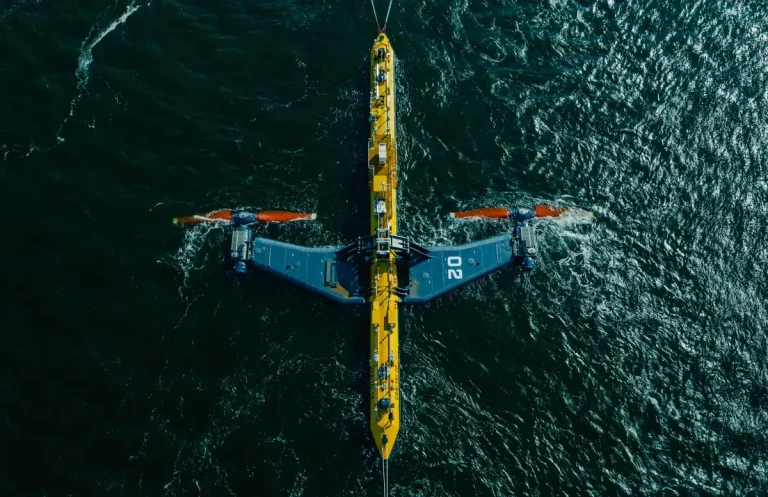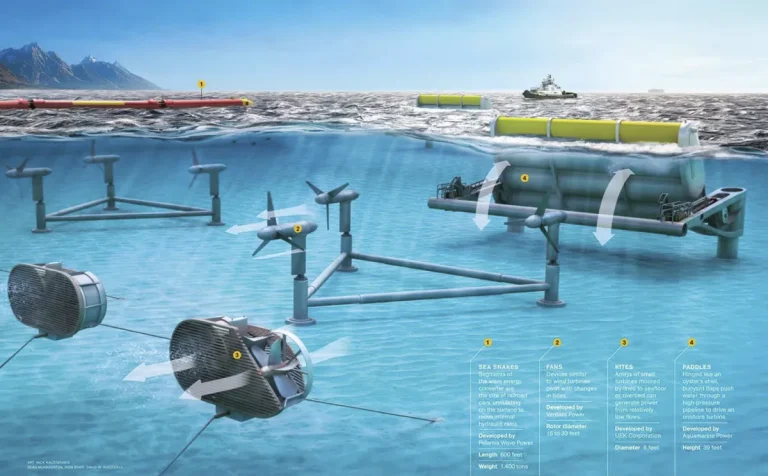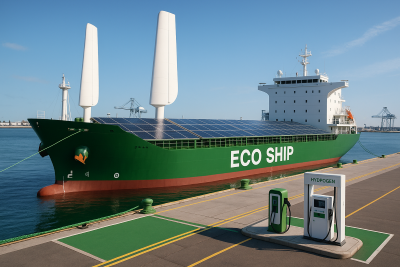How Tidal Turbines Work: A Beginner’s Guide
As the global community seeks out cleaner energy options, tidal power has surfaced as an encouraging renewable resource. In contrast to wind or solar energy, tidal energy is both predictable and stable, influenced by the gravitational forces of the moon and sun. Central to tidal energy systems are tidal turbines, underwater instruments that convert the kinetic energy from moving tides into electricity.
This beginner’s guide details how tidal turbines function, their essential components, the scientific principles behind them, as well as their benefits and obstacles. Whether you are a student, an environmental enthusiast, or simply intrigued by renewable energy, this guide will provide you with a foundational understanding.
What Is a Tidal Turbine?
A tidal turbine is a device that produces electricity from the natural ebb and flow of ocean tides. It operates similarly to a wind turbine but is submerged underwater. As tidal currents pass by, they cause the turbine blades to rotate, which are connected to a generator that creates electricity.
Tidal turbines are typically situated in tidal streams or estuaries where the water flows swiftly enough to effectively turn the blades. These turbines are components of larger systems referred to as tidal energy converters (TECs).
How Do Tidal Turbines Work?
- Harnessing Kinetic Energy
The fundamental concept behind a tidal turbine is to convert kinetic energy into mechanical energy and subsequently into electrical energy. As tidal currents flow, they exert force on the turbine blades. The water’s power rotates the blades, just as wind does for a wind turbine.
This spinning motion is transferred through a shaft to a generator, which is usually found in the nacelle (the casing situated behind the rotor). Inside the generator, magnets and coils interact to generate an electric current.
- Electricity Generation
Once the mechanical energy from the rotating blades reaches the generator, it is transformed into electricity through the process of electromagnetic induction. The generated electricity is then transmitted through underwater cables to the shore, where it can be integrated into the power grid.
- Integration with the Grid
Tidal energy systems are frequently linked to a transformer station that regulates voltage and ensures the electricity can be safely integrated into the power grid. Advanced systems may include intelligent monitoring technologies to assess performance and identify any faults.
Key Elements of a Tidal Turbine
Let’s examine the primary components of a tidal turbine:
Rotor Blades
These are the blades that rotate due to the movement of water. They are engineered to be hydrodynamic and resilient, often constructed from composite materials to withstand corrosion and the growth of marine organisms.
Nacelle
The nacelle contains the generator and the gearbox (if applicable). It shields the internal components from seawater and marine life.
Tower or Support Structure
This is the framework that secures the turbine to the seabed. Depending on the location, it may be attached to the ocean floor, on floating platforms, or on vertical columns known as monopiles.
Generator
The generator is the core of the turbine where mechanical energy is converted into electrical energy. Depending on the design, either direct-drive or geared systems may be utilized.
Power Cables
These transmit electricity from the turbine to an onshore power station. Subsea cables must be insulated and designed to withstand harsh underwater conditions.
Types of Tidal Turbines
A diverse array of tidal turbines exists, each specifically engineered for distinct marine ecosystems:
Horizontal-Axis Turbines
These devices bear resemblance to subaqueous wind turbines. The rotor’s axis is oriented horizontally, with the blades revolving in alignment with the tidal flow. They represent the most prevalent and efficacious variety.
Vertical-Axis Turbines
Characterized by blades that revolve around a vertical shaft, these turbines possess the capability to harness tidal energy emanating from any direction. Nevertheless, they are typically associated with lower efficiency and heightened design complexity.
Oscillating Hydrofoils
In lieu of rotating blades, these mechanisms employ hydrofoils that oscillate vertically with the tidal movements, thereby generating energy through that kinetic motion.
Enclosed Tip or Venturi Turbines
These turbines utilize a shroud or duct to channel water through the rotor, thereby enhancing efficiency by augmenting the velocity of the flow.
Where Are Tidal Turbines Installed?
Tidal turbines are predominantly situated in locales characterized by robust tidal currents. Such locations encompass:
Narrow straits and channels Coastal bays and estuaries Regions exhibiting a substantial tidal range (the disparity between high and low tide)
Prominent tidal energy initiatives include:
MeyGen Project in Scotland Rance
Tidal Power Station in France
Annapolis Royal Generating Station in Canada
Benefits of Tidal Turbines
- Predictable Energy Source
In contrast to solar or wind energy, tidal movements are exceedingly predictable. The forecasting of tidal patterns can extend several years into the future, rendering tidal energy a dependable option for base-load power generation.
- Low Carbon Emissions
Tidal turbines emit no carbon emissions during their operational phase, thus categorizing them as environmentally sustainable once deployed.
- Long Lifespan
These systems are engineered for durability, often designed to function effectively for two to three decades with minimal maintenance requirements when compared to wind turbines.
- Space Efficiency
Subaqueous installations do not occupy precious terrestrial space and do not detract from the aesthetic integrity of coastal landscapes.
Challenges of Tidal Turbines
Despite the potential inherent in tidal energy, several challenges persist:
- High Initial Costs
The design and installation of tidal energy systems incur significant expenses. Financial considerations encompass construction costs, seabed anchoring, transmission infrastructure, and environmental impact assessments.
- Environmental Concerns
The deployment of turbines can adversely affect marine ecosystems, particularly concerning fish populations and marine mammals. Issues such as noise pollution, habitat disruption, and collision risks necessitate meticulous management.
- Maintenance Difficulties
Maintenance operations conducted underwater present considerable complexity and financial implications. Accessing turbines for the purpose of repairs may necessitate specialized equipment and vessels.
- Limited Suitable Sites
Globally, only a limited number of sites exhibit the requisite conditions, specifically strong, consistent tidal flows and shallow seabed.
The Future of Tidal Turbines
With the advancement of technology, one can anticipate that tidal turbines will evolve to become increasingly efficient, economically viable, and environmentally benign. Innovations such as floating platforms, modular turbine designs, and AI-driven monitoring systems are already instigating transformative changes within the sector.
Accompanied by escalating investments and international advocacy for renewable energy sources, tidal power may soon occupy a pivotal role within the global energy portfolio.
Conclusion
Tidal turbines present a formidable method to exploit the energy generated by oceanic processes. They are characterized by their cleanliness, predictability, and efficiency albeit not devoid of challenges. For newcomers, acquiring a foundational understanding of the fundamental mechanics, components, and implications associated with tidal energy serves as a commendable introductory step into the realm of marine renewable resources.
Whether one is investigating tidal power for educational, investment, or sustainability purposes, this guide has equipped the reader with the essential groundwork to explore the subject more profoundly.



